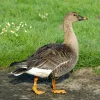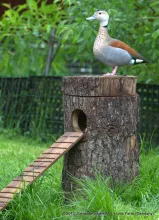
Ringed teal (Callonetta leucophrys)
Species name
- Dutch name:
- Roodschoudertaling
- English name:
- Ringed teal
- German name:
- Rotschulterente
- French name:
- Canard à collier noir
- Scientific name:
- Callonetta leucophrys
Scientific classification
- Order:
- Anseriformes
- Family:
- Anatidae
- Onderfamilie:
- Anatinae
- Genus:
- Callonetta
Description
- Description:
Male:
Head and neck are buff, with a few fine grey streaks.Black stripe on crown and down back of neck and then forward , forming half-ring at base. Breast buff- pink with small black spots, becoming buff and unspotted in front of grey flanks, which finely vermiculated with black; belly white, vent and undertail converts black but with large white patch on lower sides of the rump. Mantle light olive brown, more chestnut to the sides and on the scapulars; lower back, rump, uppertail-converts and tail black. Primaries and there converts black, secondaries iridescent green with white area on secondary converts, lesser and median converts black; underwing all dark. Bill blue-grey. Feet and legs pink.Female:
Patterned similarly overall with pale under parts barred brown and a brown face marked with pale stripes. in flight by a white greater covert patch and green secondaries.Juvenile:
Overall body plumage of Female. But the head looks more like adult male tell after first wet season.
Standard Measurements
- Body Length (cm):
- The male (drake) of the Ringed teal measures approximately 35–38 centimeters. The female measures approximately 35–38 centimeters.
- Body Weight (grams):
- The male will weight about 330–390 gram. The female will weight about 235–360 gram.
The weight is notoriously variable and can only be used as indication!
- Habitat:
Due to their small size Ringed Teal can be easily predated and this perhaps makes them particularly suitable for keeping in an aviary where a higher degree of protection can be provided. If being kept in an aviary they can also be maintained full winged and they can then be seen perching or flying up to elevated nest boxes that adds yet more interest. They readily become very tame and are a delightful duck to keep.
- Note:
Dabbling Ducks are generally hardy, easy to maintain and easy to breed. Shelter may be required by some of the smaller species in winter. They should be provided with cover (including marginal pond cover) and loafing areas as well as water. A pen which is 50% water is suggested. The water may be shallow (i.e. no more than two feet deep is required), and muddy areas for dabbling in are also appreciated. These ducks are generally good in mixed collections, although the smaller and quieter species may be bullied. Territorial disputes between ducks of the same species may be avoided by keeping only one pair of each species in an enclosure, unless the area is very large. For a single pair of ducks a pen are of 50 to 100 square metres, depending on the size of duck, should be provided.
A diet based on wheat and pellets is suggested, with maintenance pellets changed to breeders pellets for the breeding season. Bread and greenfood are also appreciated. Grit should always be available, with soluble grit (e.g. oystershell grit) as a calcium source when breeding.
Most species are ground nesters and both close ground cover and ground level nest boxes should be provided. Hand-rearing is generally preferred, as these ducks are generally poor parents in captive conditions, particularly in enclosures shared with other waterfowl. These ducks are prone to hybridization, particularly with closely related species, which should be kept apart from one another.
Ringed Teal can usually be expected to breed in their first year and as with other species that originate from sub-tropical regions they can have a very extended breeding season. They can lay from March through to September so a number of clutches can be anticipated in a season if the eggs are taken for artificial incubation. They nest in hollow trees in the wild and consequently require nest boxes in captivity and while they prefer a box raised off the ground this is by no means essential.
While they are relatively easy to breed it is not always straight forward to get the first clutch but once this has been achieved they will usually continue to lay many clutches in a season. The pair actively work together looking for a suitable nest site and it does pay to have a number of potential sites for them to investigate, this helps to stimulate the breeding process and the laying of the first egg, once this has been achieved almost nothing will stop them from laying.
If they are seen investigating potential nest boxes but do not actually lay it may be sensible to either add one or two additional nest boxes or slightly change the positions of the available nest boxes that may help trigger the laying of the first egg.
- Breeding:
- The female Ringed teal usually lays from 6-12 white eggs and incubates them for 24-28 days.
- Artificial incubating:
The ideal relative humidity for incubating most waterfowl eggs is 55% (ground nesters) and 40% (cavity nesters). The temperature is usually 37.4°C. Set ventilation as recommended by the incubator manufacturer. Eggs must be turned, either automatically or by hand, a minimum of 4 times a day. As the duckling develops there is a loss of water from the egg and the air sac gets bigger. In normal development of an egg with a 24-28 days incubation, the air sac occupies about a third of it three days earlier. Cleanliness is vital and ideally eggs should be moved to a separate hatcher at this point, where the humidity should be increased to 65% and even higher once they have pipped internally.
- Bird banding:
- Recommended closed leg band ring size for the Ringed teal is 8 mm.The leg band ring can only be applied on a young dabbling duck at around 10-12 days old.
- It doesn't matter what leg that you band, but it's good to have a consistent system. Suggested: Left leg = Female, Right leg = Male
- Rearingfeed:
-



Floatable special rearing feed for all types of aquatic ornamental fowl - especially for the cultivation of trees as well as greening ducks.
This well-balanced complete feed with 20% protein content convinces above all by its good compatibility and forms the basis for visibly healthy growth from day one.
Made exclusively from wholesome and selected raw materials, Lundi Micro Regular is also ideally suited for the year-round feeding of waterfowl.
- Maintenance food:
-





Lundi Regular with a protein content of 20%, valuable Spirulina and high-quality by-products is optimally balanced in its composition maintenance food for water ornamental fowl of all kinds. Especially green teal and Whistling ducks that are not dependent on a very high protein content, are well supplied.
Lundi Regular contains all the minerals and vitamins in full form that are important for the animals. Therefore also suitable as breeding food.





Floating full food for all sea ducks, green ducks, eider ducks and geese, especially in the moulting and breeding phase ideally suited. Packed with wholesome raw materials, natural vitamins and trace elements, this performance food with a protein content of 30% forms the basis for lifelong vitality.



